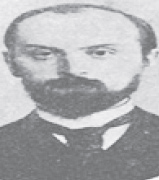
Many foreign scholars namely August Dillmann, Enrico Cerulli, Alessandro Gori, Enno Littmann, Carlo Conti Rossini, Stefan Strelcyn, I.Gudi, Anton D./Abadie, Edward Ullendorff, Paulo Marrassini ,among others, had studied Ethiopic manscripts and contributed a lot to Ethiopian Studies. Also, Turaev Boris Alexandrovich on his part researched and published different original Ethiopic manuscripts during his time. It was believed that the Ethiopic manscripts, which were studied by Turaev, were taken from Ethiopia to Russia to be presented to St. Peter’s Great Museum of Antropology and Ethnography of the Russian Academy of Science by ancient Russian scholars and by Russian officer, traveler, religious figures and publicist Aleksandr Bulatovich .As it is clear, in 1897, Bulatovich was one in the Russian Red Cross Detachment to Ethiopia. He was distinguished by atse Menelik II. He participated in three expeditions with Menelik’s armies. He also made Geographic surveys of the territory, for which he was awarded a Silver Medal from Imperial Russian Geographic Society. After his expeditions, he published the diaries of his travels in Ethiopia.(En.Ethipica,vol.1.637).
Turaev was a renowned Russian Orientalist, founder of the Russian school of history and philology of the ancient East, seminal figure in Russian Egyptology and Ethiopian studies, Academician of the Russian Academy of Sciences. He was the author of many works on Ethiopian history and the history of the church in medieval Ethiopia. He also specialized in Semetics,
Assyriology, Sumerology, Hittology, Coptic and Urartic studies.
Boris Aleksaandrovich Turaev was born on 5 August 1868 in Novogrudok, the then Belorus and died 23 August 1920 in Petersburg. He entered the Gymnassium in Vilno ( Vlnus) and then the historico-Philological faculty of St Petersburg Imperial University, where he studied Egyptology under tutorship Oskar von Lemm. After the conclusion of the course, in 1891,he was asked to stay at the University as a post- graduate student and was sent for further studies abroad for one year. He attended the lectures of a number of famous scholars such as Adolf Erman and Eugene Maspero on Egyptology , Assyriology and Geeze and worked in the Museums of Berlin , Paris, London and also in Italy, collecting the material for his magister thesis.
Saint Petersburg Imperial University
After his return in 1896 Turaev lectured on the history of the Ancient Orient Egyptiology at St. Petersburg University as assistant professor. In 1898, he was given the degree of Magister of General History of Ancient Egyptian Culture. His study allowed him substantial progress in the field of Ethiopian studies. Turaev published his first work in the field of Ethiopian Studies in 1897 based on horologium of Ethiopian Church or Metshafe Seatat. He also trans lated in to Russian and published the royal chronicles of the emperors Amade Tsion I, Zerea Yaekob, Libne Dingel, Gelawdewos and Minas. The royal Ethiopic chronicles were also edited by Kraskovski in1936. Turaev prepared a study of some Ethiopian hagiographic works, mostly Gedlat of the major Ethiopian Saints as his doctorate thesis.
Turaev undertook the investigation of Ethiopian hagiography as a whole, a work which was less recognized in the western academic tradition. Turaev first and foremost was known as a publisher of hagiographic texts. His edition of Vitea Metshafe Filippos of Debre Libanos,Samuel of the Walddibba,Aron,Ewostatewos etc,published in the series Monumenta Aethipiae hagiologica,initiated by Turaev, and in the Corpus Scriptorum Christianorum Orentalium. In 1904,he launched a second publications of Geez texts, with Russian translation( Pamiatniki efiopsko pismennosti, ‘Monuments of Ethiopian letters)’, he prepared a description of the Ethiopian manuscripts in St Peteresburg in 1906 ,and contributed to quite a number of issues of Geez literature and Ethiopian history.
Furthermore, Turaev studied hagi ography of Teamire Sellase, monastic literature, liturgy and the problem of Zera Yaekob and his Hateta, the Beale Negest, Ethiopian magic literature. Turaev was the first professor after Dorn to restart the university course of Geez in Russia, however he took the teaching of Ethiopian history and literature as his main duty. Turaev also preserved 6,000 items of Egyptian collection of Vladimir Golenishchev. Due to the efforts of his, the collection was brought from Cairo to Moscow by the Russian government and remained in Russia. In April 1911, Turaev shifted the collection to the Moscow Museum of Finearts and Catalogue.
The Russian government accom modated the cataloguing and preserving system of Turaev and appointed him to be its keeper. But Turaev did not like the idea. He was of the opinion that keeping the collection was the duties of the head of the Egyptian department of the Museum, which he performed until his death. Therefore, abandoning the University in1912, he continued his Ethiopian studies and prepared two volumes of his History of the Ancient orient, for which he was awarded the gold medal of Imperial Russian Acheaological Society. In 1913, he was elected a correspondent member of Imperial Academy of Sciences, and in 1918 a member of the Russian Academy of Sciences.
Turaev was a strong believer of Orthodox Christianity. But during the Russian revolution of 1917, he became disturbed as the atheistic regime ruined the church in a harsh and stubborn manner. Beyond that, the University Church was closed by the atheistic regime. So, Turaev made a Church in his house no 8 in the Birzavaja,a Line near the University. Turaev considered religion and spiritual culture to be the basis of historical development.
Moscow Imperial Academy of Sciences
After the 1917 Revolution, Turaev continued his scholarly activities for the last two years of his life. He attentively worked at the Petrograd (the then St.Petersburg) Theological Institute. As Sevir Chernetsov expressed, the hardship of life post- revolutionary Russia emerged everywhere, and everybody being exhausted and distressed. Then, Turaev suffered both physically and psychologically. At the end, he passed away and got buried at the Nikolskoe cemetery of St. Petersbug
(Sevir Chernetsov,En. Ethiopica, vol,4. 2010. 1002 ).
The Ethiopian Herald Sunday edition December 22/2019
By TADDELE GEDLIE TSEGAYE ( PhD )





